Note: This article was originally written in 2014 and has been updated slightly over time to maintain accuracy.
In order to understand how Republicans have gained such a stronghold on Wexford County, I had to look at the history of the Republican Party, of Wexford County, and of the Republican Party in Wexford County. What follows is what I came to understand over two years of searching for answers.
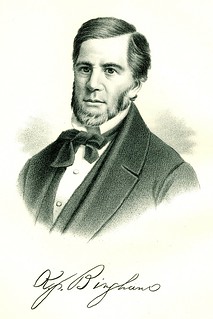
Kinsley Bingham- Michigan’s First Republican Governor (Political Graveyard)
The Republican Party was arguably born in Michigan. Most Michiganders came from the free state of New York (also true of most early residents of Wexford County) or from free states in New England. Many were also members of one of the predominant Christian denominations that existed in Michigan at the time and most of those denominations opposed slavery. Therefore, most Michiganders were against slavery to some degree in the mid 1800’s. During that time frame there were two major political parties. The Democrats were the dominant political party in Michigan, and they controlled most of the elected offices. Yet, the party was not united on the issue of slavery. While they were certainly against slavery, some believed that each territory should decide for themselves, a position known as popular sovereignty. Others strongly opposed slavery and were known as “Free Democrats.” The other major party of the time was the Whig party. The Whigs attempted to minimize slavery as an issue and were more concerned with the preservation of the Union. Third parties, like the Liberty party and later the Free Soil party, sprung up around the anti-slavery cause and had smaller followings. It was anti-slavery members from all of these parties that answered an invitation to meet in Jackson, Michigan on July 6, 1854. There was no place large enough to hold the 1,500 people who showed up, so they met outside in an oak grove and the event came to be known as the “meeting under the oaks.” One of the leaders, a Whig by the name of Zachariah Chandler, was quoted as saying “I have laid aside party to rebuke treachery.” The Republican party was meant to last “until the contest is ended.” However, the party never disbanded, though some did eventually return to their party of origin after the Civil War. The Republican Party had great success right away and won many of the open state wide elected seats in Michigan in the fall of 1854 including electing Kinsley Bingham as Governor (Bingham made the transition from Democrat to Free Soiler to Republican). In the fall of 1860, President Lincoln, a former Whig, comfortably won Michigan and became our first Republican President.

Map of Michigan highlighting Wexford County (Wikipedia)
According to the book The View from Couthouse Hill by Judge William Peterson, Benjamin Hall became the first white settler in what was to be Wexford County in 1862 a few years after Lincoln’s election. Other settlers trickled in over the next several years, the most notable of which was a former Union soldier named John Wheeler. Wheeler, a Republican, built the first mill, started a newspaper, and was elected as the first county treasurer. Wheeler lost his mill to fire in 1871, the same year as the Great Chicago Fire, and he suggested later that maybe it was set by a “deranged Democrat.” Wheeler would later write a book called the History of Wexford County which Judge Peterson used while researching his own book. In 1866 Manistee County, who administered the area that is now Wexford County, sectioned off the area as a separate township. According to Peterson’s research, the political activity of that time was dominated by the Republican party and no significant Democratic vote existed. In 1869, Wexford County was incorporated as its own county via Act 386 of the state legislature. In the first county elections in 1869 all the successful candidates were Republican save one by the name of Isaac Carpenter. Carpenter won the probate judge office because his opponent split his own vote when citizens voted for Solomon C. Worth and S.C. Worth. However, Carpenter did manage to get elected again the next year, once again the only Democrat to do so.
In 1872, the first presidential election took place since Wexford County became an official entity. A group of 40 men created a political club called the Grant and Wilson Club to support the Republican President and Vice Presidential nominee. According to Wheeler’s book, Ulysses S. Grant received 277 of the 351 votes cast in Wexford County. Grant easily won re-election. In 1876, Republican Rutherford B. Hayes actually lost the popular vote but managed to win the electoral college by 1 vote. Hayes easily won Wexford County (and Michigan) gathering 618 of 938 votes cast.
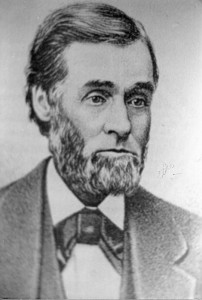
George Mitchell (Wexford Historical Society)
No one was more influential in the development of Wexford County, and specifically the town to be known as Cadillac, than a man named George Mitchell. Mitchell was invested in the G.R.&I Railroad that was making its way north towards what would be Wexford County. He envisioned lumbering the pristine pine trees and using the two lakes as a way to transport logs to the mills. Mitchell used his connections to make sure the G.R.&I railroad changed its path to travel through the most desirable location, the location that would be known as the village of Clam Lake and later as the City of Cadillac. He then bought up some 2,000 acres of land in the area. George’s older brother William Mitchell was at the “meeting under the oaks.” William, who late became a U.S. Representative, was said to be a close friend of Abraham Lincoln. One would have to imagine that George was influenced a great deal by his brother William. George himself held office as a Republican serving as Mayor in 1877, the first year that Cadillac was incorporated as a city and a year before his death in a carriage accident. Though Mitchell only served in office that one year, he was always thought to be working behind the scenes. Some people believe he was behind the political maneuvering that eventually lead to Cadillac obtaining the county seat from Manton shortly after they helped Manton obtain it from Sherman.
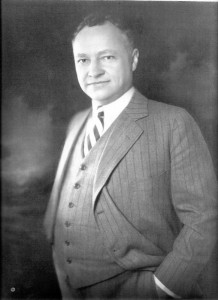
Governor Fred Green (Wexford Historical Society)
Mitchell recruited many talented men to his new village. One of those people was a mill operator from Manistee named Holden Green. Green, who had seven children, still found time to be active in local politics including serving as a judge. One of his sons, Fred Green, grew up to be the 31st Governor of Michigan and held office as a Republican from 1927-1931.
The most influential person in Cadillac after Mitchell’s death though was a Republican businessman named Jacob Cummer, and to a lesser extent a number of his family members. Like Mitchell, Jacob serve one term as a mayor (1878). Also like Mitchell, Cummer had his hand in a number of business interests and many of them revolved around the lumbering industry. The Cummers had such influence that one paper said in 1889 “Cadillac means Cummer.” The wages, hours, and conditions in the community were based off what the Cummers where paying. It went beyond that though. According to Peterson’s book, Cummer employees “had to vote” and they knew that “bad votes caused unemployment.” One person who became unemployed was Professor H.M. Enos. Enos was fired as superintendent of the school in large part because he also owned a newspaper that was critical of the Cummers. The school board President, by the way, was Jacob Cummer.
There were a few men who spoke out against the Cummer empire. One of them was a Democrat named Joseph (James) Haynes who Peterson said was “perhaps the most popular man ever to live in Cadillac.” Haynes was a “constant irritant” to Jacob Cummer until his untimely death in 1878. At the time of his death, Haynes held office as both the Mayor of Cadillac and the treasurer of Wexford County. Haynes had an ally in successful businessman Jonathan Cobbs. Cobbs “thought of his employees as his friends” and “came to dread the solemn single-minded, and relentless drive for profits that later developed in the Cadillac lumber community.” Cobbs actually shared his profits with his employees and allowed them to buy shares in his mill. Surprisingly, Cobbs was a business partner with William W. Mitchell, the Republican nephew of George Mitchell. One of Cadillac’s most lasting names is Democrat Ephraim Shay. Shay made a name for himself as an inventor of the famous Shay Locomotive, the first of which he build in 1881. Shay also served one term as the county treasurer (1879) though it took the “fused” efforts of both Democrats and Greenbacks to get him elected.

A Shay Locomotive built for the Cummers. (Wexford Historical Society)
Local historian Cliff “Top” Sorgren pointed out that many of Cadillac’s early Republicans donated generously to charity and should not be “compared with today’s greedy profit-seekers.” George Mitchell donated the land for the Maple Hill Cemetery, the City Park, and the site for Cadillac’s first school building. Jacob and Wellington W. Cummer donated land for the site of the first library, now the Wexford Historical Society building. Fred Diggins, who was twice a delegate to the Republican National Convention and served many years as mayor, along with his wife Delos Diggins financed the building and equipment for Mercy Hospital. Cummer, Diggins, and another fellow named Wilcox teamed up to donate the land that is now known as Diggins Hill and the adjacent water tower area. William W. Mitchell also contributed to parklands and many other charitable causes.
Perhaps the first in depth national political mapping project also gives some insight into the politics of Wexford County, and the entire region, at the time. Scribner’s 1883 map shows that 60-70% of Wexford County voted for the Republican Presidential Candidate James Garfield in the 1880 election. The strength of the Republican brand at the time can also be seen in the interesting political career of a local man named David Rice. Rice was a three time Republican prosecutor. In 1880 he decided to run as an independent instead of a Republican and lost. In 1884 he ran again as a Republican and won. For some reason Rice ran as a Democrat in 1886 and 1888 and lost. He ran as a Republican in 1892 and in 1894 and won!
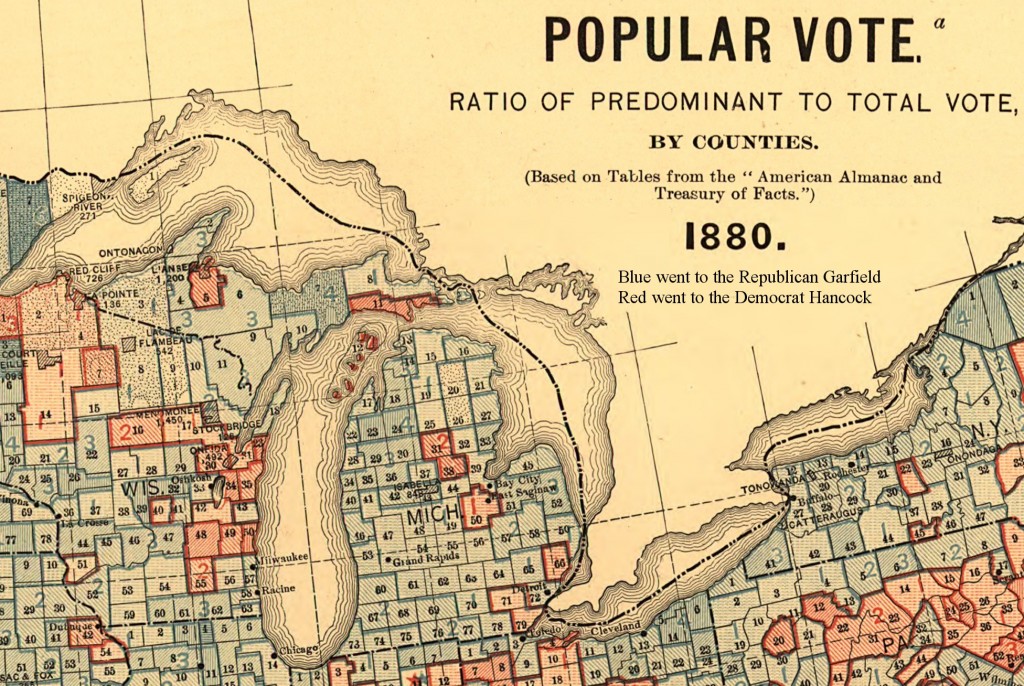
Note that for some reason blue represents counties won by Republicans and Red counties won by Democrats.
In each decade after the 1880 election, it seems that a Democrat managed to win the mayor’s office for a year. Levi Law, who a local paper called the Republican News said “suffered from “Indiana Democracy,” served one term in 1889. Law was said to have “good humor and quick wit” even though “he suffered the stigma of being a Democrat in a Republican Community.” Democrat George S. Stanley was elected as mayor in 1901. He also only served one term and was defeated in five other attempts at the office! Democrat Frank O. (F.O.) Gaffney won election as Mayor for one term in 1910. It is unclear if another Democrat has served as mayor since. Currently the City Council is elected using a non-partisan ballot.
The county elections from 1890 to 1902 tell an interesting story. In 1890, Republicans won six of the seven seats. In 1890 to 1902 they won all of the seats. The Republicans’ margin of victory became noticeably wider over that period, and in the last two elections the Democrats didn’t even run a candidate for two of the seats.
Cliff “Top” Sorgren remembers the Republican domination continuing throughout the 1900’s. Sorgren grew up in Cadillac during the 1930’s and said he “sat in on many family after dinner discussions where the term ‘Roosevelt’ was considered an obscenity.” Roosevelt was elected in 1932, but Wexford County went for Hoover according to the Cadillac Evening News. Henry W. Miltner, who graduated from UofM law school in 1908, was a Democratic Presidential Elector that year. The Miltner family seems to have chalked up most of the Democrats’ victories in the 1900’s. In 1937, Henry’s son Charles got elected as prosecutor. Apparently, 1937 was a banner year for Democrats because they won five offices that year. Later, Charles ran for circuit court judge with the backing of the state’s Bar Association and many local lawyers. However, the Cadillac Evening News’ publisher T.O. Huckle was instrumental in making sure a Republican candidate got elected instead according to Charles’ son John Miltner. Charles’ brother Frank was elected as prosecutor, the only Democrat elected to office in Wexford County in 1946, according to the Cadillac Evening News. Frank later served as a district court judge until 1984. John Miltner ran against Pete Hoekstra for the 2nd congressional district in 1992. He was only able to muster 35% of the vote though. That seems to be where the Miltner family’s political influence in the area ends. The vast majority of the hundreds of other elections over the century were taken by the Republicans. In fact, no Democrat has ever been elected to represent Wexford County in the State House of Representatives except in one township (see list at bottom of page) as far as I can tell.
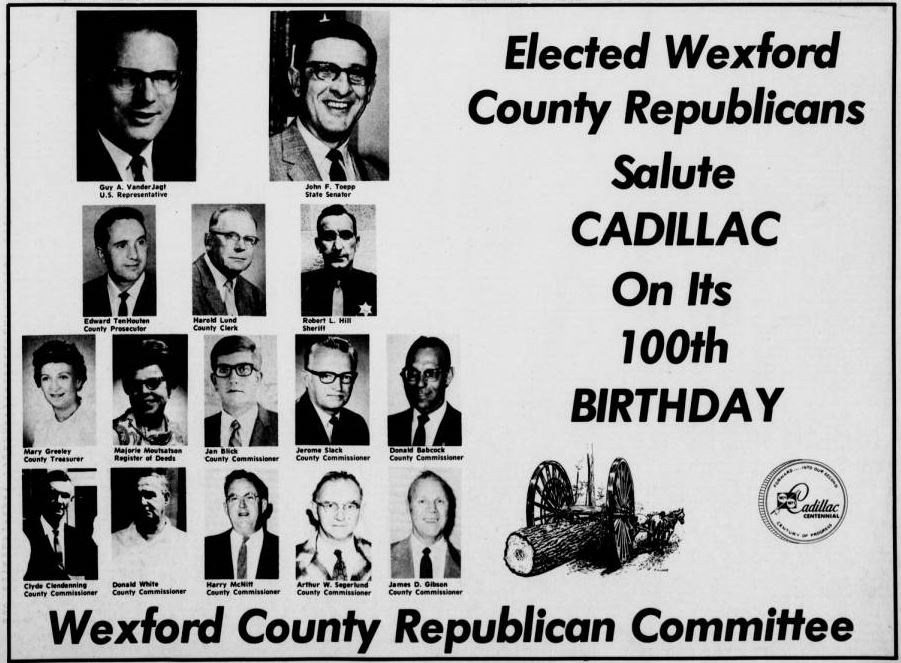
Advertisement in the Cadillac Evening News 1971 Centennial Edition.
So why has there been a complete and utter dominance by Republicans in Wexford County? Long time Cadillac High School history teacher Bill Allen took on that question for a master’s thesis. He hypothesized that it was the “rugged individualism” of those early settlers like John Wheeler that lead them to identify with the model of a more limited government. We also cannot discount that the Republican party was a homegrown Michigan effort and was, and still is, pretty popular almost everywhere in Michigan. A third possibility is that Wexford County has always thrived on the manufacturing industry that requires low skill labor. Since the low skill labor force in Wexford County has seldom been organized into unions, the owners of those businesses have wielded far greater power than the workers.
A final question might be are the Republican’s poised to continue their domination of Wexford County politics? It appears likely. Republican businessmen still win most of the elections in the county. In fact, Republicans often have no Democratic challenger in local elections. Yet, history teaches us that the right Democrat could be successful. If someone as charismatic as Haynes, or as talented as Shay came along, they could tug enough moderate Republicans and independents to the left to obtain a victory. Surely that will happen again someday right? The question is when, and can it be sustained for any length of time? Or perhaps citizens might find themselves unhappy with today’s major political parties and create a new party like they did in 1854. Time will tell.
State Representatives Who Represented Wexford County
Antrim, Charlevoix, Crawford, Emmet, Grand Traverse, Kalkaska, Leelanau, Manistee, Missaukee, & Wexford
John S. Dixon (1863-1864)
Antrim, Benzie, Crawford, Grand Traverse, Lake, Kalkaska, Leelanau, Manistee, Mason, Missaukee, Otsego, & Wexford (Charlevoix added for 1871 & 2)
William H. Mitchell (1869-72) -Republican from E. Traverse Bay
(not related to George Mitchell or his nephew William as far as I know)
Crawford and Manitou, Grand Traverse, Kalkaska, Missaukee, & Wexford
Thomas Ferguson (1873-1876) – Republican from Sherman
Grand Traverse & Wexford
James L. Gibbs (1877) – from Mayfield
Henry May (1880) -Republican from Cadillac
Seth C. Moffit (1881-82) -Republican from Northport
Kalkaska, Lake, Missaukee Counties& Wexford Counties
Benjamin C. Bonnell (1883) -Republican from Sherman Township
George Oviatt (1885) – Republican from Chase
Lake & Wexford Counties
George Oviatt (1887) – Republican from Chase
Sylvanus Alexander – (1889-1892) – Republican from Wexford
H. Frank Campbell- (1893-1896) -from Sherman
John Caldwell – (1897-1900) -Republican from Manton
Sylvanus Alexander – (1901-1902) -Republican from Wexford County
Orville Dennis- (1901-03) – from Lake City
Earl Fairbanks – (1903-1906) – Republican from Luther
John A. Barry – (1907-1908) – Republican from Harrietta
Victor F. Huntley -(1909-1910) – Republican from Manton
Frank A. Smith – (1915-1924) – Republican from Luther and later Cadillac
H. Earl McNitt – (1925-1936) – Republican from Haring Township
Charles H. Nixon – (1937-1942) – Republican from Cadillac
Manistee-Wexford District
John D. Kruse- (1943-1954) – Republican from Manistee
Charles A. Boyer – (1955-62) – Republican from Manistee
John (Jack) F. Toepp – (1963-1964) – Republican from Cadillac
104th District
Arnell Engstrom- (1965-1968) – Republican from Traverse City
Michael Dively – (1969-1974) – Republican from Traverse City
Connie Binsfeld (1975-1982) – Republican from Maple City
Note: Slagle Township was not in the same district as the rest of Wexford County between 1973 and 1982. Slagle was part of the 98th district and was represented by the following individuals:
Dennis Cawthorne- (1973-78) – Republican from Manistee
Jeff Dongvillo (1979-1980) – Democrat from Scottville
Ed Giese (1981-82) – Republican from Manistee
18th District 1980-82
Sidney Ouwinga- (1983-1991) -Republican from Marion
John Gernaat (1991- 1997) -Republican from McBain
102nd House of Representatives
John Gernaat – (1997-1998) -Republican from McBain
Rick Johnson – (1999-2004) -Republican from LeRoy
Darwin Booher (2005-2010) -Republican from Evart
Phil Potvin (2011-2016) -Republican from Cadillac
Michele Hoitenga (2017-2021) -Republican from Manton
101st House of Representatives
Joseph Fox (2022-current) -Republican from Fremont
Special Thanks: This post could not have been written without the amazing work of Judge William Peterson. A View from Courthouse Hill is a local treasure that too few people know about and less have read. I also have to thank local resident Bob Garner who once worked in the Legislative Service Bureau and who gave me the name Dennis Cawthorne. Cawthorne once represented a portion of Wexford County. Cawthorne’s memory has no equal and he was instrumental in figuring out who represented the Wexford County area in the state legislature for a good part of the mid 1900’s on. Surprisingly, that era was the hardest to find information on. I’d also like to thank John Miltner for his assistance with his family history. Finally, I’d like to thank Susan Schulten, Department Chair at the University of Denver, for helping me obtain and make sense of the 1883 Scribner’s map. If you have a correction or an addition, please contact me (Chad Phillips) at michiganpopulist@gmail.com
References:
A History of Northern Michigan and its People. Perry F. Powers. 1912
Cadillac Evening News Centennial Edition. 1971
History of Wexford County Michgian. John Wheeler. 1903
Michigan: From Primitive Wilderness to Industrial Commonwealth.
M.M. Quaife, PH.D. and Sidney Glazer, Ph. D. Prentice-Hall, Inc. 1948 New York
The Political Graveyard Website: Politicians Who Lived in Wexford County
The View from Courthouse Hill. William R. Peterson. 1974
*This post was originally written
 The pre-primary campaign finance statements are now online and they paint a stark contrast between Governor Rick Snyder and his opponent Mark Schauer. Governor Snyder had 69 individuals donate the maximum contribution of $6,800 this period. Those 69 people netted his campaign almost half a million dollars alone. Snyder had about 6,500 total donors whose average donation was about $510. Surprisingly, none of Michigan’s billionaires, whose income grew 22% in the last year under his economic plan, are among those donors. However, two out-of-state billionaires did donate to Snyder. Conservative crusader David Koch, the 6th richest person in the world, donated the maximum amount Former New York City Mayor Michael Bloomberg, the 14th richest person in the world, also donated the maximum amount. Meanwhile, Mark Schauer had only three individuals donate the maximum amount. Schauer also had a lot more donors this period, over 17,000, and his average donation was about $110. These numbers clearly show who will work for the populace and who will work for the prosperous.
The pre-primary campaign finance statements are now online and they paint a stark contrast between Governor Rick Snyder and his opponent Mark Schauer. Governor Snyder had 69 individuals donate the maximum contribution of $6,800 this period. Those 69 people netted his campaign almost half a million dollars alone. Snyder had about 6,500 total donors whose average donation was about $510. Surprisingly, none of Michigan’s billionaires, whose income grew 22% in the last year under his economic plan, are among those donors. However, two out-of-state billionaires did donate to Snyder. Conservative crusader David Koch, the 6th richest person in the world, donated the maximum amount Former New York City Mayor Michael Bloomberg, the 14th richest person in the world, also donated the maximum amount. Meanwhile, Mark Schauer had only three individuals donate the maximum amount. Schauer also had a lot more donors this period, over 17,000, and his average donation was about $110. These numbers clearly show who will work for the populace and who will work for the prosperous.














